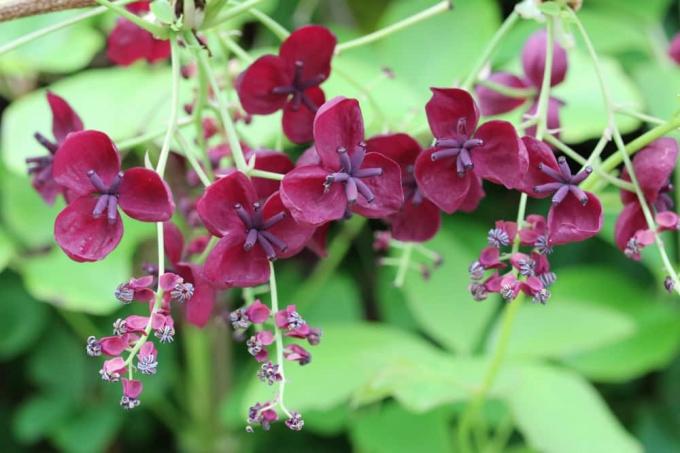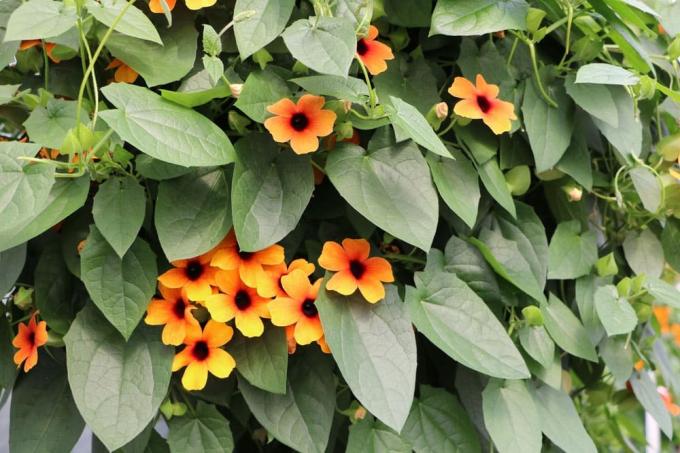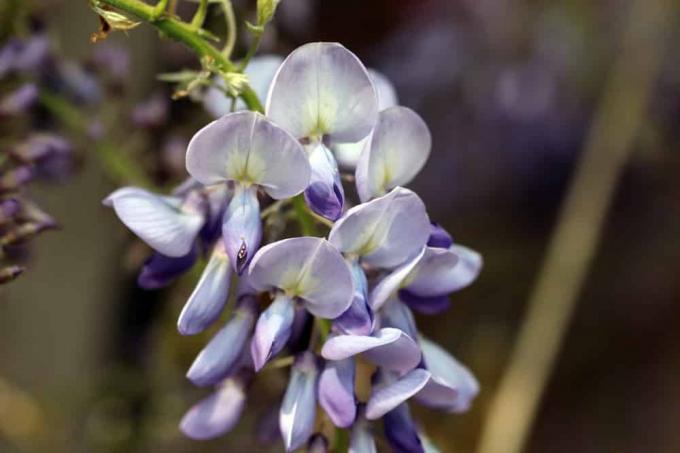

Table of contents
- characteristic
- sowing and planting
- Location
- Care
- hibernate
- multiply
- diseases and pests
- Conclusion
- Care tips in brief
Thanks to its decorative, dark green leaves, the finger-leaved climbing cucumber is extremely popular with gardeners who like unusual plants. Despite its beauty, the Akebia Quinata has not been widespread in Germany so far. However, there are a few things to keep in mind when caring for them. Read here how to make the climbing plant the highlight of your garden.
characteristic
The five-leaf Akebie is becoming increasingly popular in Germany, even if it has not yet reached the spread of other ornamental plants. Supported by a climbing aid, the Akebie can grow up to seven meters high, and under favorable conditions even twelve meters and is therefore particularly suitable for greening facades. In addition, it can also be planted as a privacy screen for terraces or stand as a trellis at the edges of corridors and paths. The origin of the Akebia Quinata lies in the mountainous regions of East Asia. Accordingly, it should also be planted in sunny places. The climbing plant has no problems with wind, as long as it is not too strong. A wind-protected place is still good for her. Due to its size, the stability of the climbing aid must be taken into account. It has its heyday in May, when it bears both female, violet-brown and male, pink flowers and exudes a pleasant, aromatic fragrance. Thanks to its smell, the plant is also called "chocolate wine". Its fruits are edible and are considered to be particularly healthy given their East Asian origin. For example, they are said to prevent cancer.
sowing and planting
The chocolate vine can be sown from April to May. Note that the plant needs space and therefore keep a distance of at least 50cm to the next plant. Unfortunately, the seeds only germinate very irregularly, which is why rearing them does not always lead to the desired sense of achievement, especially for beginners. It is much safer to build directly on seedlings. These can be brought into the ground in summer and have a significantly higher tolerance for unfavorable environmental conditions. Make sure that the plant gets enough sunlight and is watered sufficiently. This is the only way the climbing cucumber can grow to its full beauty.
The finger-leaved climbing cucumber grows only hesitantly at first. After two years at the earliest, it gets dense foliage, and plant lovers can only enjoy its magnificent flowers after five years. In warm climates it tends to form underground runners. If you want to avoid this, it is best to create a rhizome barrier. Its fruits do not reach full maturity until October, but then they are tasty and beneficial to health.
Location
The finger-leaved climbing cucumber can cope with any ordinary soil, but there are a few points to consider:
choose a sunny or partially shaded location
- support the growth with trellis or climbing aids, such as poles, ropes or trellis
- Provide adequate watering, but avoid overwatering at all costs
- Prevent the plant from drying out by covering the soil around it with leaf or bark mulch
- With proper care, the climbing cucumber is particularly suitable for facade greening or as a privacy screen
Care

The chocolate wine is extremely undemanding and does not have to be specially thought of. Only a sufficient supply of water must be ensured if it is to develop its true splendor. However, overwatering should be avoided. Therefore, only reach for the watering can when the top layer of soil is dry. To prevent drying out, it is advisable to cover the soil around the plant with leaves or bark mulch all year round. This ensures that the soil does not lose too much moisture even in strong sunlight. In order to enable optimal growth of the plant, it should be planted in deep and humus-rich soil. The strong foliage of the plant leads to lignification. To prevent this, it is advisable to regularly unravel the shoots. Pruning of the Akebie should not be done too frequently. The shoots can be shortened about every three to four years. Then, however, you can also get down to business boldly to stimulate new shoots.
hibernate
The Akebie is an extremely undemanding plant, which is also reflected in the requirements for overwintering. Adult climbing cucumbers are quite frost-resistant and can easily overwinter outdoors in our latitudes. Nevertheless, gardeners should make sure that the plant receives winter protection at severe minus temperatures (from -10°C and below). If it is too cold for her, the Akebia reacts by shedding leaves. If this is the case, extreme caution is required. Unlike adult plants, young chocolate vine should be protected in winter.
multiply
The chocolate wine can be propagated in two ways: On the one hand, offshoots can be grown, which are then planted from April to May. In addition, it is also possible to obtain seeds from the large fruits. However, if you are hoping for the method of rapid propagation, you should consider that the plant will bear its first fruits after five years at the earliest. It should also be noted that the seedlings grow slowly and urgently need protection in winter.
diseases and pests
The chocolate wine is susceptible to the common spider mite. Otherwise it is extremely robust and hardly susceptible to local pests.
Conclusion
The finger-leaved climbing cucumber is a newcomer to local gardens. Nevertheless, it has all the character traits that are conducive to further dissemination. Since it is very easy to care for and looks good, it is an excellent alternative to ivy as a typical facade greening in our latitudes. Thanks to its tasty fruits, it even has the character of a useful plant in addition to its functional aspects. The chocolate wine is therefore a real insider tip, especially for garden lovers with a penchant for the exotic.
Care tips in brief
Location
The Akebia prefers a sunny to half-shady location. It should be warm and protected from the wind.
plant substrate
A nutrient-rich, sandy-humic plant substrate is recommended. However, the plant can also cope with any normal garden soil. It is important that the soil is well drained so that unneeded irrigation and rainwater can drain away.
watering and fertilizing
If the plant has had enough water throughout the summer, its leaves will remain for a long time. But it mustn't get too cold, or they'll fall off anyway.
climbing aids
The fast-growing chocolate wine needs a framework, if possible a trellis, with horizontal and vertical struts. Cable systems are ideal. In view of the growth rate, kits of the same weight should be used. When cultivating in a tub, a light kit is usually sufficient. The chocolate wine winds its way up to a height of seven meters.
cut
You don't have to cut the chocolate wine, but you can. It is enough to thin out every two to three years. If necessary, you can make a vigorous pruning of individual shoots in early spring. This stimulates new growth in the base area.
winter protection
Akebia are only conditionally hardy. Young plants in particular need winter protection. You should therefore plant them on warm walls that still radiate heat in winter. Protection is particularly necessary in rough situations.
propagation
The chocolate wine can be produced by sowing, cuttings or Propagating root cuttings. The cultivation of seeds, which can now be bought, is not entirely unproblematic. They seeds germinate with difficulty and irregularly. It is best to sow them in the cold frame in the fall. You can also stratify them 4 to 6 weeks. They are then laid superficially in a mixture of seed soil and sand, kept warm (15 to 18 ˚C) and kept very moist, but never wet. 10 seeds cost between 2 and 3 euros. Propagation by cuttings in summer is much easier. Buying such a small plant is not much more expensive than a bag of seeds that will not grow.
 garden editorial
garden editorial I write about everything that interests me in my garden.
Learn more about climbing plants

Is black-eyed Susan poisonous?
Black-eyed Susanne can delight all of our eyes with colorful flowers. But if small children or pets are around it, it is important that we also clarify whether it is possibly poisonous. The answer to that is clear and a little surprising!

Black-eyed Susanne, Thunbergia alata: Care from A – Z
Black-eyed Susanne is one of the most popular climbing plants. It is ideal for greening house walls, balconies, fences and pavilions. If you follow our care tips, you will enjoy the splendor of their flowers.

How fast does wisteria grow? | Information about growth
As its name suggests, the wisteria, as an intensive climber, enriches walls, trellis structures and other possibilities for spreading a magnificent, glowing blue sea of flowers. You can find out what you should consider when growing with us in a simple and understandable way.

How fast does Virginia creeper grow? | Information about growth
If you want a trellis or a house wall to be lushly greened, you will find a grateful partner in Virginia creeper. Over time, it can grow into large areas and, especially in autumn, enrich it with colorful foliage. Contact us for helpful information on growth.

Evergreen honeysuckle: care from A to Z
The evergreen honeysuckle is popular for greening walls or fences, because the creeper is green all year round and has beautiful delicate flowers. Although the honeysuckle is not very sensitive, it needs a minimum of care for it to develop well.

How fast does ivy grow? | Accelerate growth effectively
Ivy (Hedera helix) is a true climber that climbs up walls and house walls without any problems and can have a very decorative effect. Once it has taken root, it can literally overgrow large areas in a very short time. You can literally watch him grow.



